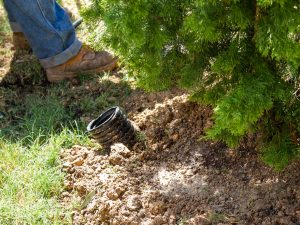How to Install a Soil Moisture Pipe
How to Install a Soil Moisture Pipe
To ensure proper watering, we recommend installing 4-inch perforated drainage pipes on all trees. The perforations allow excess water at the bottom of the rootball to drain freely into the pipe. These pipes provide convenient access to the rootball, making it easier to determine if trees are being overwatered or underwatered. Samples should be collected at the bottom corner of the rootball. Taking samples too far from the rootball edge or at an incorrect depth can lead to inaccurate readings, even with minor deviations. Here is a chart showing the approximate locations where the samples should be taken:
| Container Size | Distance from Center of Trunk | Depth |
| 15 Gallon | 11 Inches | 12 Inches |
| 20 Gallon | 14 Inches | 15 Inches |
| 30 Gallon | 14 Inches | 15 Inches |
| 45 Gallon | 17 Inches | 17 Inches |
| 65 Gallon | 18 Inches | 18 Inches |
| 95 Gallon | 21 Inches | 21 Inches |
| 200 Gallon | 26 Inches | 24 Inches |
Dig an 8-10 inch wide hole along the side of the rootball using a post-hole digger or spade shovel. Continue digging until you reach the bottom of the rootball. Place the 4-inch perforated pipe in the hole, ensuring it touches the edge of the rootball along its entire length and doesn't extend below the rootball's base. Backfill the hole with soil, taking care not to fill the pipe.



 Treeland Nursery
Treeland Nursery
972-372-4737
Facebook Twitter Pinterest Instagram Youtube Houzz